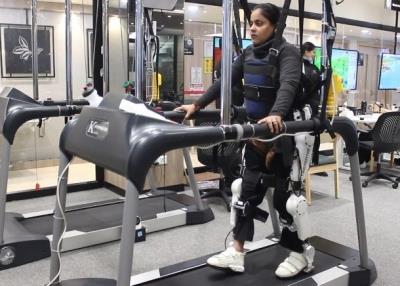(MENAFN- IANS) By Rachel V Thomas
New Delhi, May 7 (IANS) For 28-year-old Sarika, a make-up artist, life came to a standstill after she was confined to a wheelchair with paralysis following gunshot wounds in her lower back.
Joginder Sharma, 60, had a severe accident while walking, making his left hand and leg extremely weak.
A fall from a horse ride left K.M. Aggarwal, 67, partially paralysed. He was not able to sit independently, and was also unable to stand and walk.
Saloni Sabharwal, 26, had a spastic cerebral palsy, which meant she had difficulty in standing, walking, turning on her bed, and sitting from a lying position. Her posture was incorrect and she could only walk with two-person support.
All these patients are now walking, doing their daily activities on their own, without support after being trained by a wearable robotic exoskeleton that is designed to assist people with weakened or impaired limb function, Dr Sachin Kandhari, Senior Neurosurgeon and Managing Director, IBS Hospital, told IANS.
Known as Cyberdyne Medical Hybrid Assistive Limb (HAL), it is a brain-controlled robotic system deployed at IBS Hospital that trains the human brain to make movement, helping the patients to reverse paralysis and live a better quality of life.
Kandhari said IBS Hospital is the first centre in India and the South-East Asia region to introduce the non-invasive approach.
Developed by Japanese scientists, HAL is the world's first cyborg-type wearable robot and is based on a new technology called 'cybernics', in which the machine and human are connected and share information in real time, allowing the machine to support the voluntary movement of the wearer. HAL detects bioelectrical signals on the skin surface and provides support to the wearer's voluntary drive.
"HAL works by detecting the weak electrical signals generated by the user's muscles and amplifying them with sensors, which then power the movement of the robotic exoskeleton," Kandhari said.
This means that users can control the exoskeleton with their own muscle signals, allowing them to move their limbs with greater ease and precision. The system can also be customised to provide different levels of assistance, depending on the user's level of impairment, he said.
The robotic technology can help people with stroke, spinal cord injury, traumatic brain injury, multiple sclerosis, muscular dystrophy, cerebral palsy and other neurological disorders that affect their ability to move their limbs.
"The HAL technology has the potential to significantly improve the quality of life for people with impaired limb function, by enabling them to perform tasks that were previously difficult or impossible," Kandhari said.
"I remember feeling really helpless to see myself completely bedridden and dependent on others even for my daily chores. I lost all hope after the doctors told me that the paralysis cannot be reversed," Sarika, a makeup artist, told IANS.
"Today I am not only able to walk and do my daily chores, but have also resumed my work as a makeup artist ," she added.
The wearable robot is to be worn during training and each patient's condition, the severity of impairment, and the frequency of use of the technology will determine the length and benefit of treatment.
Kandhari said that the hospital is in talks with the government and NGOs for scaling up the technology at government centres to help the common population to avail it.
"The government and private sectors need to come together and accept the need for such treatments and then adapt it. We have already been working with the neuro department of AIIMS-Delhi to use this treatment. The technology use can be scaled up because it does not require highly specialised manpower," he noted.
(Rachel V Thomas can be contacted at )
--IANS
rvt/prw/dpb
MENAFN07052023000231011071ID1106192452
Legal Disclaimer:
MENAFN provides the
information “as is” without warranty of any kind. We do not accept
any responsibility or liability for the accuracy, content, images,
videos, licenses, completeness, legality, or reliability of the information
contained in this article. If you have any complaints or copyright
issues related to this article, kindly contact the provider above.

















Comments
No comment